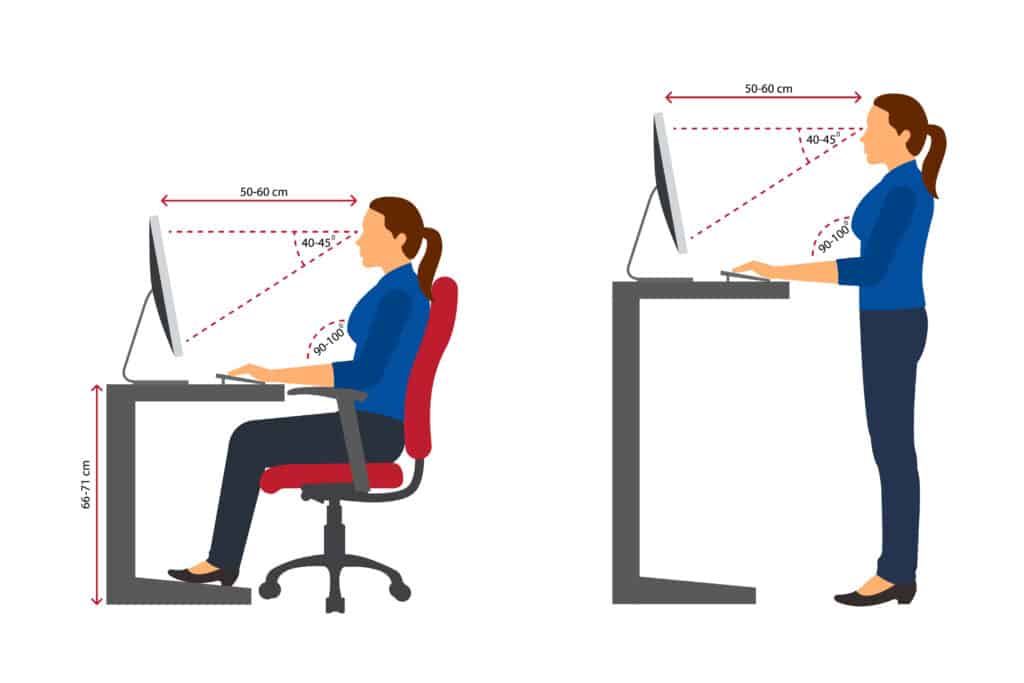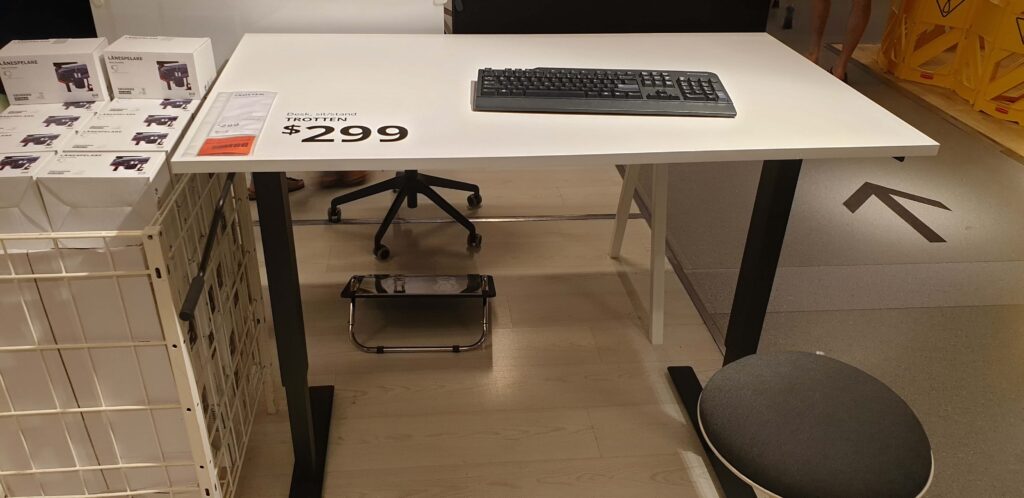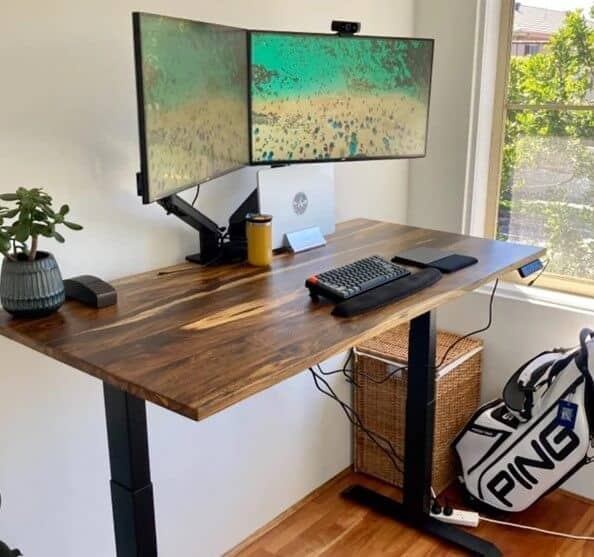Are Standing Desks Worth It?
Manual and electric standing desks seem to be all the rage since the early 2000s due to their positive perceptions of the physical health of office workers. But as more research has been conducted over the years, the benefits of standing desks are now better understood. Does our improved understanding still warrant them as a worthy investment for your quality of life?
Key Takeaways:
- Standing desks provide immediate positive effects on your psychological behaviours and well-being by introducing more body movement into your working day. Especially if you zen the standing desk space to provide a relaxing environment to increase productivity.
- The long-term benefits of sit-stand desks on physical health are not fully understood and more studies are required.
- Surveys indicate a 40% increase in the level of standing desk adoption in US workplaces.
Are Electric Standing Desks Worth The Hype?
If you are expecting to burn calories and lose weight whilst using a standing desk then you would be incorrect. Whilst you would burn slightly more calories standing than sitting but using an electric standing desk simply isn’t enough to make a significant difference. Despite being hyped up to make you lose weight, there are not enough studies conducted to assess potential weight loss over the long term.
However, choosing a good standing desk create an almost instantaneous positive impact on your working behaviours and your well-being by encouraging more body movements. These go a long way to improving your mood as well as reducing discomfort.
Are Standing Desks Becoming More Popular?
Standing desks are not a new phenomenon but it does feel like they are gaining popularity in many Australian workplaces, homes and offices. As more and more people have become aware of the benefits of keeping active at a sit-stand desk, they have slowly become more popular in the workplace as a perk or simply by request of employees.
According to an online survey conducted by Statista, 20% of respondents in 2014 indicated they would be able to get a standing desk from their employer, with those figures rising to 60% in 2019. The increase of 40% over a five-year period strongly suggests that workplaces are adopting the use of sit-stand desks more openly.

Are Standing Desks Better Than Sitting?
There are limited studies that have investigated the health benefits of standing desks and there remains inconclusive proof that there is significant net benefit. While evidence suggests that some health benefits can be realised, the psychological and behavioural effects are relatively well established.
In 2019, a literature review of 53 scientific studies concluded that sit-stand desks were major factors in promoting positive behaviours for people who used them. Assessed across six categories including behaviour, psychological, work performance, physiological, discomfort, and posture, it was concluded that behaviours were changed as a result of standing desks. But there were only mild effects for health benefits. Regarding the categories assessed, adjustable height desks have the most positive impacts on alleviating discomfort through alternating periods of sitting and standing, and the least for productivity.
Published in the International Journal of Public Health, a Japanese study in 2021 concluded that the use of standing desks by office workers in the workplace environment improved vitality, workplace engagement, and self-assessment productivity over a four-week period. There was also a statistically significant difference between the control group and the standing desk group that demonstrated reduced sedentary behaviours and improved worker health and productivity.
Overall, standing desks are better at encouraging behavioural change than sitting for excessive periods of time. The short-term health benefits such as reduced comfort in the legs, buttocks, neck, and shoulders are fairly well known, however, the long-term advantages are still unclear.
The Benefits Of Standing Desks
The health benefits of using a standing desk will vary from person to person. Whilst some benefits are well documented, some require more study to ascertain if there is a real net benefit to be had over the long term.
Your posture will improve
As long as you are standing in a natural and upright position from time to time, standing desks promote better posture compared to sitting. This is because standing requires more muscles and it encourages a more natural alignment of the spine that can help prevent or alleviate back and neck pain. At a base level and from personal experience, height-adjustable desks do a good job of making you think about your body more in terms of your posture and general health. However, there are guidelines that you should follow for how long to stand at a standing desk that you should also consider to benefit your posture.

Reduced risk of cardiovascular issues
Whether standing desks actually play a role in mitigating cardiovascular disease and other related issues remains unknown. However, we do know that living a sedentary lifestyle is a factor in these types of health conditions. Using a standing desk can help improve blood circulation and reduce the strain on the cardiovascular system.
Improved energy and focus
Increased body movement using a standing desk promotes energy during the day and increases your attention span and focus. Although the direct cause is known, it is likely due to the increased blood flow to the brain which enhances cognitive function. In fact, increased energy and focus are one of the reasons why some workplaces invest in standing desks for their staff.
Reduced risk of certain chronic diseases
Prolonged sitting has been linked to an increased risk of various chronic diseases including type 2 diabetes, heart disease, and certain types of cancer. Using a standing desk can help mitigate these risks but more research is needed to establish the long-term benefits, if any.
Increased productivity
Changing between sitting and standing can help to prevent stagnation during the working day. Because of this, some people may experience heightened productivity and even creativity. Although this benefit is cited in some studies, the jury is still out on whether standing desks actually increase productivity, particularly in the long term.
Reduced risk of musculoskeletal issues
Sitting for extended periods can lead to musculoskeletal problems such as tight hips, a strained neck, and lower back pain. Standing desks can help alleviate these issues by encouraging more movement and variety in a posture where the muscles are engaged and naturally become stronger over time to support you.
Improved mood
Standing and moving throughout the day can stimulate the release of endorphins and improve mood which helps alleviate stress and anxiety.
Collaboration and communication
Since standing desks allow you to work upright, they help to break down communication barriers between co-workers in an office environment. Increased communication means increased collaboration which is why more and more workplaces in Australia are bulk purchasing sit-stand desks. The same can be said in schools which is one of the objectives of Aussie Active Desks.
The Drawbacks Of Standing Desks
Despite the advantages, there are some drawbacks of standing desks that you should be aware of.
Discomfort and fatigue
Standing for prolonged periods can lead to discomfort and fatigue in the legs, lower back, and feet. This can potentially outweigh the benefits of standing if not managed properly. For more information on whether standing desks are good for your knees, read this article.
Inadequate ergonomics
Just like sitting at a desk, using a standing desk with poor ergonomics can lead to discomfort and musculoskeletal issues. It’s important to set up the desk, monitor, keyboard, and other accessories in a way that promotes proper posture.
Reduced social interaction
If you work in an office environment where most colleagues are sitting, using a standing desk might affect your ability to interact with others comfortably. The real benefit is realised when all employees have the ability to stand and this is known to increase communication and collaboration.
Transition discomfort
Transitioning from a sedentary work routine to using a standing desk can initially cause discomfort as your body adjusts to the new posture and demands.
Footwear considerations
Wearing improper footwear can exacerbate discomfort while standing so it’s important to wear supportive shoes at your standing desk that are comfortable for extended periods. Otherwise, consider using an anti-fatigue mat to support your feet and legs.
Cost
Standing desks are quite the investment that will take a portion of your budget. Even the cheapest brands will cost around a few hundred dollars. Standing desks from Ikea, often the first place Australians will browse, start from $299 for the most basic and featureless Trotten desk.

For mid-range to premium standing desks such as the UpDown PRO, expect to pay between $500 to $1,200 depending on the accessories that you buy alongside. Nevertheless, high-quality standing desks and ergonomic accessories can be more expensive than traditional desks and chairs.
Why Are Standing Desks Good For Pain and Discomfort?
Have you ever noticed that it gets uncomfortable to sit in the same position for more than a handful of minutes? This is because there is no movement in your body and muscles will start to tighten over time.
This is where standing desks come in. Since you alternate between a standing and sitting position multiple times a day, you end up moving your body which gets the muscles going. The same can be said for standing all day which is known to have negative physiological effects.
Therefore, it is not standing at a desk that alleviates pain and discomfort, but it’s the movement itself. By changing your posture, you are engaging your body to make a range of movements that gets blood flowing to different parts of the body.
Standing desks are great for alleviating pain and discomfort as they promote a range of movements. In addition to standing and sitting on an ergonomic chair, you could even introduce different seated positions by using an exercise ball to really see the benefits.
The Pros & Cons Of Using Standing Desks
Pros
- Extremely good tools for enhancing your well-being during the working day.
- They can be customised to suit your individual needs.
- Medium to top-tier standing desks will last a long time.
- Most come with digital controllers that can be programmed for different height settings.
Cons
- They carry a fairly large cost and represent a sizeable investment.
- Transitioning to a standing desk might be challenging and can take some time.
Who Benefits Most from Standing Desks?
A standing desk will be sure to benefit the majority of Australians. However, the groups of people who should seriously consider buying a sit-stand desk include:
- Primary, secondary, and tertiary-level students spend a lot of time studying, reading, or typing on the computer. An electric desk with the right accessories can really enhance the learning experience.
- 9 am to 5 pm office workers typically spend the day in a seated position and there are limited or no opportunities to travel (e.g., site visits), go outdoors, or go for walks.
- Artists, designers, and other creative professionals where flexibility in the workplace is sought after. Sewing is a great example of a creative hobby where alternating standing and sitting is highly beneficial.
- People who work from home and have large amounts of sitting time.
Should You Buy A Standing Desk?
Whether you should buy a standing desk depends on your personal circumstances, the type of work you do, and your budget. Despite this, the net benefit of incorporating a height-adjustable desk into your workplace or home can be too hard to ignore and it will be a great investment for most Australians.

Before you fork out the money to purchase one, you should perform a self-assessment of your working habits and preferences to help inform your decision-making process. After all, you might decide that a full-size sit-stand desk is too large for the space available, it costs too much, and a top-quality desk converter might be the better option.
Conclusion
Standing desks are not fitness equipment and don’t replace the need to participate in physical exercise or supplement your diet. Instead, they are good tools to increase your well-being by encouraging better behaviours whilst you work or study. If you spend a great deal of time behind the computer or desk then investing in a sit-stand desk will greatly improve your quality of life.
Frequently Asked Questions
Standing desks are known to promote good health, well-being, and better working behaviours. Whilst the long-term effects on physical health are not fully understood, the short-term benefits are well established. These include increased vitality, productivity, collaboration, and decreased discomfort since body movement is heightened when alternating between sitting and standing positions.
The purpose of a standing desk is to break up prolonged periods of sitting. Because more body movement occurs when using a standing desk, they offer clear short-term health benefits that normal desks can’t provide. Studies show that it’s the movement, not the standing that provides advantages such as reduced discomfort.
Related: